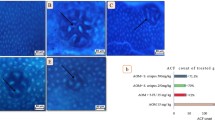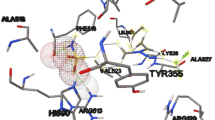Abstract
Objective
Colon cancer is a common malignant neoplasm causing huge morbidity and mortality worldwide. Current therapeutic interventions are unsatisfying, which necessitates novel chemopreventive strategies. The present study was intended to elucidate the chemopreventive efficacy of hesperidin against azoxymethane (AOM)-induced mouse colon carcinogenesis.
Materials and methods
Swiss albino mice were subjected to intraperitoneal injections of AOM once a week for 3 consecutive weeks. Hesperidin treatments were provided in the initiation or post-initiation phases. The number and multiplicity of aberrant crypt foci (ACF), tumor incidence and antioxidant status were determined. Histopathological analyses, proliferating cell nuclear antigen (PCNA) index and modulations in the expression of inflammatory markers such as nuclear factor kappa B (NF-κB), inducible nitric oxide synthase (iNOS) and cyclooxygenase-2 (COX-2) were studied.
Results
Hesperidin treatments significantly inhibited the number and multiplicities of AOM-induced ACF and tumor incidence. Hesperidin reduced oxidative stress parameters and enhanced antioxidant status. A marked decrease in the PCNA index was evident on hesperidin administration. Hesperidin treatments caused a prominent downregulation of NF-κB and its target molecules iNOS and COX-2, thereby combating inflammation.
Conclusion
This study proves the chemopreventive efficacy of hesperidin against the deleterious traits of colon carcinogenesis including accelerated proliferation, inflammation and persistent oxidative stress.











Similar content being viewed by others
References
Siegel R, Ward E, Brawley O, Jemal A. Cancer statistics 2011: the impact of eliminating socio economic and racial disparities on premature cancer deaths. CA Cancer J Clin. 2011;61:212–36.
Jemal A, Bray F, Center MM, Ferlay J, Ward E, Forman D. Global cancer statistics. CA Cancer J Clin. 2011;61:69–90.
Thompson PA, Gerner EW. Current concepts in colorectal cancer prevention. Expert Rev Gastroenterol Hepatol. 2009;3:369–82.
Wei EK, Giovannucci E, Wu K, Rosner B, Fuchs CS, Willett WC, Colditz GA. Comparison of risk factors for colon and rectal cancer. Int J Cancer. 2004;108:433–42.
Tapas AR, Sakarkar DM, Kakde RB. Flavonoids as nutraceuticals: a review. Trop J Pharm Res. 2008;7:1089–99.
Birt DF, Hendrich S, Wang W. Dietary agents in cancer prevention: flavonoids and isoflavonoids. Pharmacol Ther. 2001;90:157–77.
Boateng J, Verghese M, Shackelford L, Walker LT, Khatiwada J, Ogutu S, Williams DS, Jones J, Guyton M, Asiamah D, Henderson F, Grant L, DeBruce M, Johnson A, Washington S, Chawan CB. Selected fruits reduce azoxymethane (AOM)-induced aberrant crypt foci (ACF) in Fisher 344 male rats. Food Chem Toxicol. 2007;45:725–32.
Nishino H, Tokuda H, Satomi Y, Masuda M, Onozuka M, Yamaguchi S, Takayasu J, Tsuruta J, Takemura M, Ii T, Ichiishi E, Kuchide S, Okuda M, Murakoshi M. Cancer chemoprevention by phytochemicals and their related compounds. Asian Pac J Cancer Prev. 2000;1:49–55.
Benavente OG, Castillo J, Alcaraz M, Vicente V, Del JA, Ortuno A. Beneficial action of Citrus flavonoids on multiple cancer-related biological pathways. Curr Cancer Drug Targets. 2007;7:795–809.
Garg A, Garg S, Zaneveld LJ, Singla AK. Chemistry and pharmacology of the Citrus bioflavonoid hesperidin. Phytother Res. 2001;15:655–69.
Patricia KW, Dalla SS, Mirian S. Antioxidant activity of the flavonoid hesperidin in chemical and biological systems. J Agric Food Chem. 2005;53:4757–61.
Kamaraj S, Ramakrishnan G, Anandakumar P, Jagan S, Devaki T. Antioxidant and anticancer efficacy of hesperidin in benzo(a)pyrene induced lung carcinogenesis in mice. Invest New Drugs. 2009;27:214–22.
Leef KH, Yehb MH, Kao ST, Hung CM, Liu CJ, Huang YY, Yeh CC. The inhibitory effect of hesperidin on tumor cell invasiveness occurs via suppression of activator protein 1 and nuclear factor-kappa B in human hepatocellular carcinoma cells. Toxicol Lett. 2010;194:42–9.
Andriantsitohaina R, Duluc L, Rodriguez JCG, Valle LGD, Garcia MG, Simard G, Soleti R, Su DF, Perez LV, Wilson JX, Laher I. Systems biology of antioxidants. Clin Sci (Lond). 2012;123:173–92.
Heijstek MW, Kranenburg O, Rinkes IHMB. Mouse models of colorectal cancer and liver metastases. Dig Surg. 2005;22:16–25.
Ashokkumar P, Sudhandiran G. Protective role of luteolin on the status of lipid peroxidation and antioxidant defence against azoxymethane-induced experimental colon carcinogenesis. Biomed Pharmacother. 2008;62:590–7.
Beelen VA, Spenkelink B, Mooibroek H, Sijtsma L, Bosch D, Rietjens IM, Alink GM. An n-3 PUFA-rich microalgal oil diet protects to a similar extent as a fish oil-rich diet against AOM-induced colonic aberrant crypt foci in F344 rats. Food Chem Toxicol. 2009;47:316–20.
Wargovich MJ, Brown VR, Morris J. Aberrant crypt foci: the case for inclusion as a biomarker for colon cancer. Cancers. 2010;2:1705–16.
Hall PA, Levison DA, Woods AL, Yu CCW, Kellock DB, Watkins JA, Barnes DM, Gillett CE, Camplejohn R, Dover R, Waseem NH, Lane DP. Proliferating cell nuclear antigen (PCNA) immunolocalization in paraffin sections: an index of cell proliferation with evidence of deregulated expression in some neoplasms. J Pathol. 1990;162:285–94.
Pikarsky E, Neriah YB. NF-κB inhibition: a double-edged sword in cancer? Eur J Cancer. 2006;42:779–84.
Murakami A, Ohigashi H. Targeting NOX, INOS and COX-2 in inflammatory cells: chemoprevention using food phytochemicals. Int J Cancer. 2007;21:2357–63.
Lala PK, Chakraborty C. Role of nitric oxide in carcinogenesis and tumor progression. Lancet Oncol. 2001;2:149–56.
Watanabe K, Kawamori T, Nakatsugi S, Wakabayashi K. COX-2 and iNOS, good targets for chemoprevention of colon cancer. BioFactors. 2000;12:129–33.
Bird RP. Observation and quantification of aberrant crypt foci in murine colon treated with a colon carcinogen: preliminary findings. Cancer Lett. 1987;37:147–51.
Lowry OH, Rosebrough NJ, Farr AL, Randall RJ. Protein measurement with the Folin phenol reagent. J Biol Chem. 1951;193:265–75.
Ohkawa H, Ohishi N, Yagi K. Assay for lipid peroxides in animal tissues by thiobarbituric acid reaction. Anal Biochem. 1972;95:351–8.
Cederbaum AI, Cohen G. In: Packer L, editor, Methods in enzymology. San Diego: Academic Press; 1984. pp. 516–522.
Misra HP, Fridovich I. The role of superoxide anion in the autoxidation of epinephrine and a simple assay for superoxide dismutase. J Biol Chem. 1972;247:3170–5.
Sinha AK. Colorimetric assay of catalase. Anal Biochem. 1972;47:389–94.
Rotruck JT, Pope AL, Ganther HE, Swanson AB, Hafeman DG, Hoekstra WG. Selenium: biochemical role as a component of glutathione peroxidase. Science. 1973;179:588–90.
Staal GE, Visser J, Veeger C. Purification and properties of glutathione reductase of human erythrocytes. Biochim Biophys Acta. 1969;185:39–48.
Moron MS, Depierre JW, Mannervik B. Levels of glutathione, glutathione reductase and glutathione S-transferase activities in rat lung and liver. Biochim Biophys Acta. 1979;4:67–78.
Omaye ST, Urnbull JB, Sauberlich HE. Selected methods for the determination of ascorbic acid in animal cells, tissues and fluids. Methods Enzymol. 1979;62:1–11.
Desai ID. Vitamin E analysis method for animal tissues. Methods Enzymol. 1984;105:138–43.
Takayama T, Katsuki S, Takahashi Y, Ohi M, Nojiri S, Sakamaki S, Kato J, Kogawa K, Miyake H, Niitsu Y. Aberrant crypt foci of the colon as precursors of adenoma and cancer. N Engl J Med. 1998;339:1277–84.
Miyamoto S, Yasui Y, Ohigashi H, Tanaka T, Murakami A. Dietary flavonoids suppress azoxymethane-induced colonic preneoplastic lesions in male C57BL/KsJ-db/db mice. Chem Biol Interact. 2010;18:276–83.
Gee JM, Hara H, Johnson IT. Suppression of intestinal crypt cell proliferation and aberrant crypt foci by dietary quercetin in rats. Nutr Cancer. 2002;43:193–201.
Kohno H, Tanaka T, Kawabata K, Hirose Y, Sugie S, Tsuda H, Mori H. Silymarin, a naturally occurring polyphenolic antioxidant flavonoid, inhibits azoxymethane-induced colon carcinogenesis in male f344 rats. Int J Cancer. 2002;101:461–8.
Leonardi T, Vanamala J, Taddeo SS, Davidson LA, Murphy ME, Patil BS, Wang N, Carroll RJ, Chapkin RS, Lupton JR, Turner ND. Apigenin and naringenin suppress colon carcinogenesis through the aberrant crypt stage in azoxymethane-treated rats. Exp Biol Med. 2010;23:710–7.
Valko M, Izakovic M, Mazur M, Rhodes CJ, Telser J. Role of oxygen radicals in DNA damage and cancer incidence. Mol Cell Biochem. 2004;266:37–56.
Skrzydlewska E, Stankiewicz A, Sulkowska M, Sulkowski S, Kasacka I. Antioxidant status and lipid peroxidation in colorectal cancer. J Toxicol Environ Health. 2001;64:213–22.
Valko M, Rhodes CJ, Moncol J, Izakovic M, Mazur M. Free radicals, metals and antioxidants in oxidative stress-induced cancer. Chem Biol Interact. 2000;160:1–40.
Mates JM, Sanchez JF. Antioxidant enzymes and the implications in pathophysiologic processes. Front Biosci. 1999;4:D339–45.
Roberta M, Roberta DB, Rosaria V, Carmela F, Claudio G. Novel mechanisms of natural antioxidant compounds in biological systems: involvement of glutathione and glutathione-related enzymes. J Nutr Biochem. 2005;16:577–86.
Kojo S. Vitamin C: basic metabolism and its function as an index of oxidative stress. Curr Med Chem. 2004;11:1041–64.
Burton GW, Ingold KU. Auto oxidation of biological molecules: the antioxidant activity of vitamin E and related chain-breaking phenolic antioxidants in vitro. J Am Chem Soc. 1981;103:64–72.
Evan GI, Vousden KH. Proliferation, cell cycle and apoptosis in cancer. Nature. 2001;411:342–8.
Bedi A, Pasricha PJ, Akhtar AJ, Barber JP, Bedi GC, Giardiello FM, Zehnbauer BA, Hamilton SR, Jones RJ. Inhibition of apoptosis during development of colorectal cancer. Cancer Res. 1995;55:1811–6.
Galati G, Teng S, Moridani MY, Chan TS, Brien PJO. Cancer chemoprevention and apoptosis mechanisms induced by dietary polyphenolics. Drug Metabol Drug Interact. 2000;17:311–49.
Kubben FJGM, Haesevoets AP, Engels LGJB, Baeten CGMI, Schutte B, Arends JW, Stockbrugger RW, Blijham GH. Proliferating cell nuclear antigen (PCNA): a new marker to study human colonic cell proliferation. Gut. 1994;35:530–5.
Ravichandran K, Velmurugan B, Gu M, Singh RP, Agarwal R. Inhibitory effect of silibinin against azoxymethane-induced colon tumorigenesis in A/J mice. Clin Cancer Res. 2010;16:4595–606.
Velmurugan B, Singh RP, Agarwal R, Agarwal C. Dietary-feeding of grape seed extract prevents azoxymethane-induced colonic aberrant crypt foci formation in Fischer 344 rats. Mol Carcinog. 2010;49:641–52.
Terzic J, Grivennikov S, Karin E, Karin M. Inflammation and colon cancer. Gastroenterology. 2010;138:2101–14.
Perkins ND. Integrating cell-signalling pathways with NF-kappa B and IKK function. Nat Rev Mol Cell Biol. 2007;8:49–62.
Karin M. NF-κB as a critical link between inflammation and cancer. Cold Spring Harb Perspect Biol. 2009;1:a000141.
Wang S, Liu Z, Wang L, Zhang X. NF-kB signaling pathway, inflammation and colorectal cancer. Cell Mol Immunol. 2009;6:327–34.
Kojima M, Morisaki T, Sasaki N, Nakano K, Mibu R, Tanaka M, Katano M. Increased nuclear factor-κB activation in human colorectal carcinoma and its correlation with tumor progression. Anticancer Res. 2004;24:675–82.
Rao CV. Nitric oxide signaling in colon cancer chemoprevention. Mutat Res. 2004;555:107–19.
Williams CS, Mann M, Dubois RN. The role of cyclooxygenases in inflammation, cancer, and development. Oncogene. 1999;18:7908–16.
Acknowledgments
This work was supported by a fund from the Council of Scientific and Industrial Research (CSIR), New Delhi. We thank Dr. Ramamurthy, Director, Ultra-fast Process Laboratory, University of Madras for his help in confocal imaging.
Author information
Authors and Affiliations
Corresponding author
Additional information
Responsible Editor: Liwu Li.
Rights and permissions
About this article
Cite this article
Saiprasad, G., Chitra, P., Manikandan, R. et al. Hesperidin alleviates oxidative stress and downregulates the expressions of proliferative and inflammatory markers in azoxymethane-induced experimental colon carcinogenesis in mice. Inflamm. Res. 62, 425–440 (2013). https://doi.org/10.1007/s00011-013-0595-2
Received:
Accepted:
Published:
Issue Date:
DOI: https://doi.org/10.1007/s00011-013-0595-2




